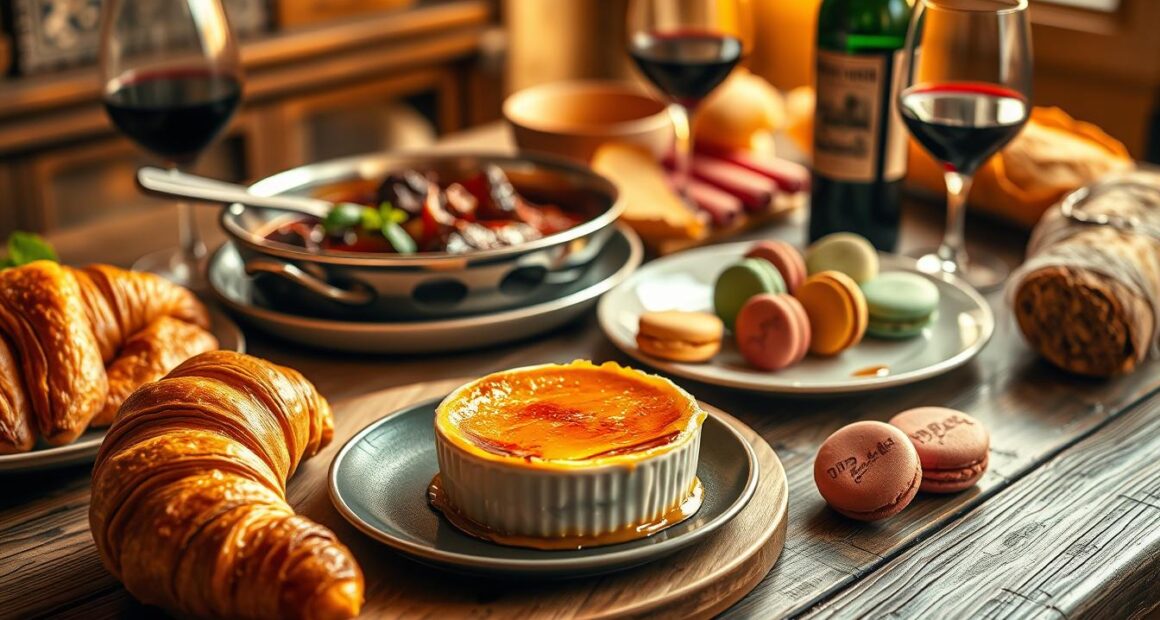Imagine the aroma of fresh herbs dancing in the air, the sound of bubbling sauces simmering on the stove, and the warm embrace of a beautifully baked baguette. French cuisine doesn’t just satiate the stomach; it stirs the soul, inviting you to indulge in a world of flavors, textures, and unforgettable culinary experiences. In a nation where over 1,500 types of cheese exist and where meals are celebrated as moments to savor, French cooking offers something extraordinary for every palate.
This article will guide you through five must-try French dishes that embody the essence of gourmet French cuisine. Each dish is a culinary gem, steeped in history and tradition, illustrating the artistry of traditional French cooking. Whether you’re preparing a Coq au Vin for a cozy dinner party or indulging in the sweet allure of Tarte Tatin, these dishes will elevate your culinary journey and ignite a passion for French flavors that lingers long after the last bite.
Key Takeaways
- French cuisine is renowned for its rich flavors and artistic presentation.
- Cheese plays a vital role, with France boasting over 1,500 varieties.
- Classic dishes like Coq au Vin highlight traditional cooking techniques.
- Every dish has a story, rooted in history and cultural significance.
- Preparing French dishes at home can transform ordinary meals into extraordinary experiences.
- Exploring French culinary gems opens up a world of delectable tastes.
An Introduction to French Cuisine
French cuisine stands as a beacon of culinary excellence, celebrated for its tradition and innovative spirit. Characterized by a strong emphasis on fresh ingredients and artistic presentation, this unique French cuisine has captivated food lovers worldwide. As you explore authentic French recipes, you’ll uncover a marriage of history and flavor that reflects the rich culinary traditions of France.
What Makes French Cuisine Unique?
The uniqueness of French food lies in its diverse regional influences and dedication to quality. Each region showcases distinct flavors and cooking methods, from the hearty dishes of the north to the vibrant recipes of the south. Techniques passed down through generations enhance the preparation of meals, while the artistry poured into wine and cheese creation demonstrates France’s haute culinary culture. By appreciating these aspects, you gain insight into the soul of French dining, which emphasizes not just eating but experiencing food.
The Importance of Fresh Ingredients
Fresh ingredients are the backbone of authentic French recipes, allowing the natural flavors of each component to shine. From crisp vegetables to rich meats and aromatic herbs, what’s on your plate reflects the seasonality of local produce. Chefs prioritize sourcing these elements to ensure that every dish is not only visually appealing but also bursting with flavor. This commitment to freshness supports the culinary traditions that define French cuisine, elevating it to an art form.
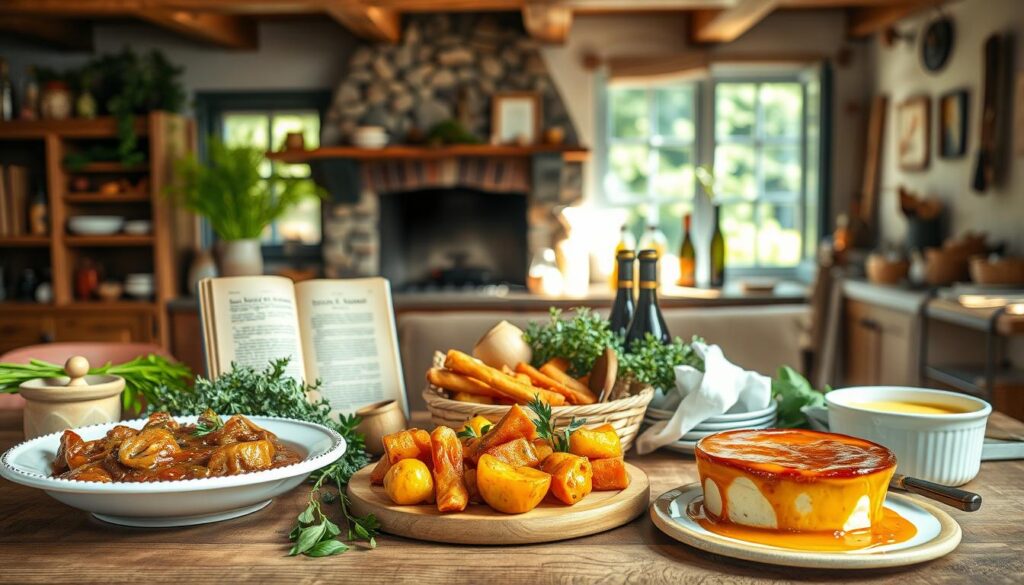
The Essence of French Cooking Techniques
Exploring the heart of French cuisine involves delving into classic French cooking techniques. These methods have shaped culinary traditions and are critical for anyone aspiring to master traditional French recipes. From sautéing to braising, these skills form the foundation of flavor in countless dishes.
Classic Techniques You Should Know
Learning essential culinary techniques is vital to creating authentic French meals. Mastery of specific methods enhances your cooking repertoire. Here are some key techniques that you should practice:
- Sautéing: A quick cooking method using a small amount of fat to brown food over high heat.
- Braising: A slow-cooking technique that combines both moist and dry heat, perfect for tougher cuts of meat.
- Poaching: Submerging food gently in water or broth, which keeps it tender and flavorful.
- Confit: A preserving method involving slow-cooking meat in its fat, resulting in rich flavor.
The Role of Sauces in French Cooking
French sauces play a crucial role in enhancing the flavors of a dish. Mastery of sauce making is an integral part of classic French cooking techniques. Sauces like béchamel, hollandaise, and demi-glace bring depth and richness to meals, elevating simple ingredients into sophisticated and delightful plates. Here’s a glimpse of some essential sauces:
| Sauce | Main Ingredients | Key Characteristics |
|---|---|---|
| Béchamel | Butter, flour, milk | Creamy base for many dishes, a mother sauce |
| Hollandaise | Egg yolks, butter, lemon juice | Rich and tangy, ideal for eggs and vegetables |
| Demi-glace | Brown stock, red wine | Intensely flavored, perfect for meat dishes |
Understanding the importance of these sauces provides insight into the artistry of French cuisine. This mastery not only showcases cooking skills but also offers chances to impress guests with traditionally inspired dishes that resonate in flavor and elegance.
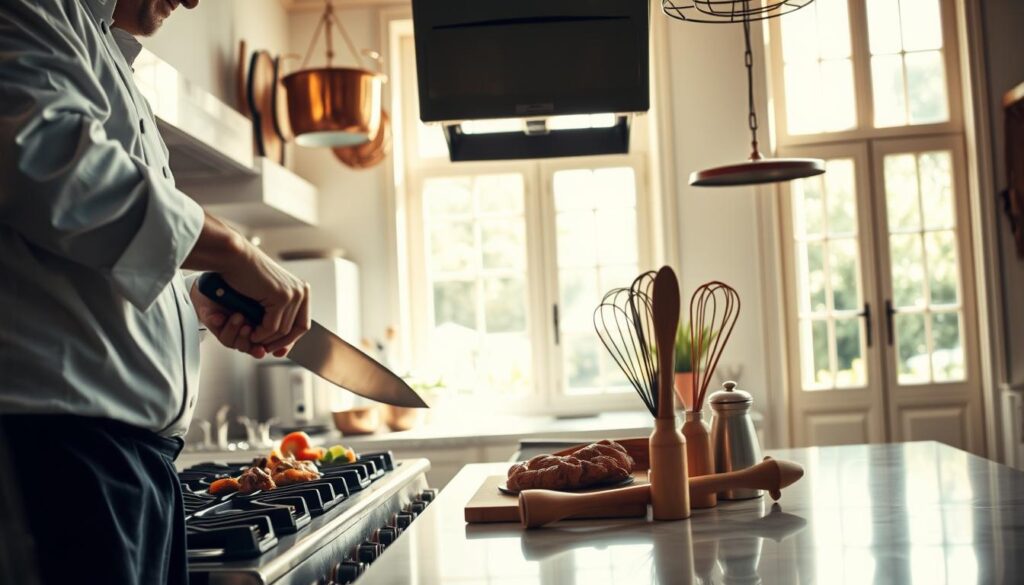
Exploring Regional French Dishes
French cuisine showcases an incredible variety shaped by the country’s diverse geography and cultural influences. As you explore regional French dishes, you will discover a wealth of flavor diversity that represents the local ingredients and traditional practices of each area. From the coastal delights of Brittany to the rich stews of the Southwest, every region offers unique contributions to the overall French food heritage.
Highlighting the Varieties in Flavor
Each region in France boasts its distinctive flavors, often influenced by neighboring countries and its local produce. The Hauts-de-France region, for instance, features hearty ingredients such as cheeses, potatoes, and meats. A classic dish from this area is Carbonnade Flamande, a delightful beef stew made with dark beer. In contrast, the Grand Est region celebrates its German influence with dishes like Choucroute Garnie, a savory combination of sausages and cooked cabbage, alongside the beloved Tarte Flambée, reminiscent of pizza.
From Provence to Normandy: A Culinary Journey
Your culinary journey through France will also take you to the flavors of Provence, known for dishes like Bouillabaisse, a fish soup that emphasizes the region’s fresh seafood. Normandy adds to this tapestry with its rich dairy products, creating iconic dishes and products like buttery Camembert and ciders. Traditional French cooking is often about celebration and the careful preparation of ingredients, leading to exceptional dining experiences that tell the story of France’s rich food heritage.
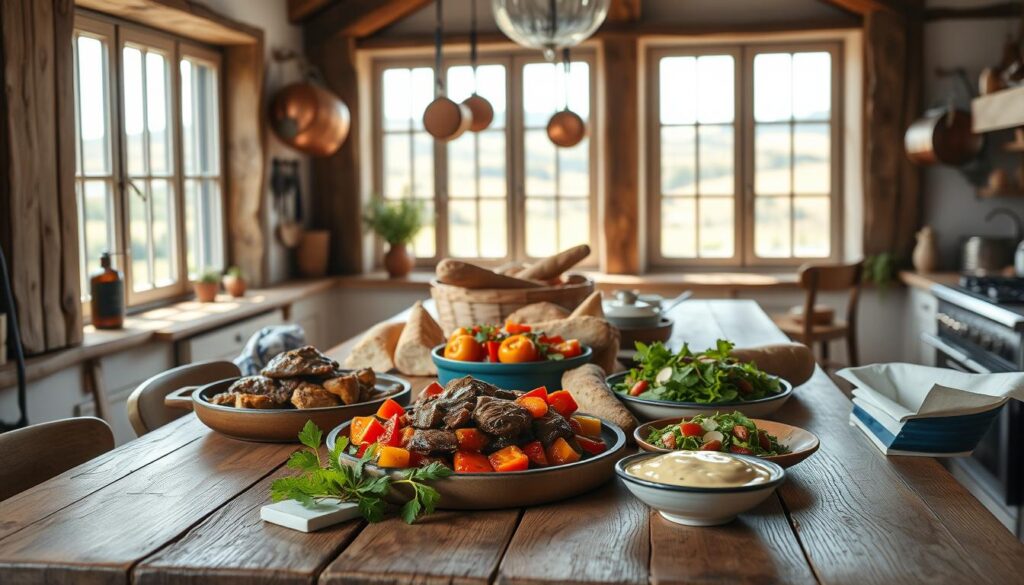
Why French Cuisine is Perfect for Home Cooks
Exploring French cooking at home opens the door to a world of flavors and techniques. You might think that creating classic dishes requires significant expertise, but many easy French recipes are designed for home cooks. With basic ingredients and some key cooking essentials, you can recreate beloved French dishes that impress family and friends.
Easy Recipes to Get You Started
Many beginner-friendly options await you in French cuisine. Ratatouille, for example, is a vibrant vegetable dish that requires simple sautéing techniques and fresh produce. French Onion Soup, with its comforting flavors, only demands a few staple ingredients and some patience. These easy French recipes not only enhance your skills in home cooking but also encourage you to experiment and get creative in the kitchen.
Cooking Essentials for French Dishes
Equipping your kitchen with the right tools simplifies the process of French cooking at home. A quality chef’s knife ensures precision when chopping ingredients. A cast iron skillet is perfect for searing and browning, while a dependable saucepot is ideal for simmering sauces and soups. Having these cooking essentials on hand transforms your culinary experience, allowing you to focus more on the art of cooking rather than struggling with inadequate tools.
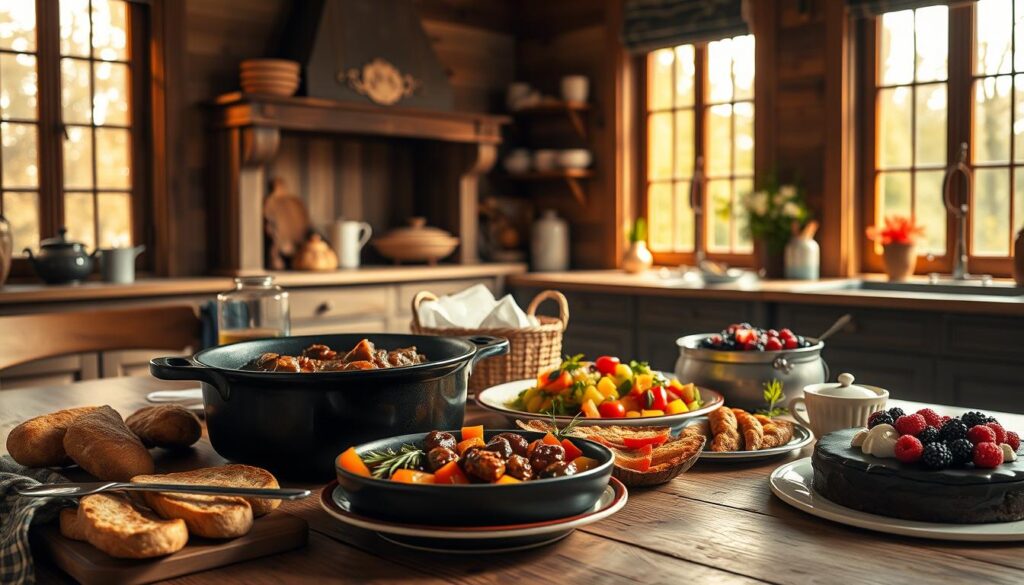
The Role of Wine in French Dining
The integration of wine in French dining enhances both the meal and the atmosphere. Selecting the right wine complements your French dish, achieving a harmonious balance that truly elevates the dining experience. Understanding wine pairing is essential, as specific wines can accentuate flavors and textures in your dishes, contributing to a memorable culinary adventure.
Pairing Wine with Your French Meal
When it comes to wine pairing, guidelines often suggest that red wines accompany richer meat dishes, while white wines pair beautifully with lighter seafood and poultry options. Some classic pairings include:
- Confit de Canard with a robust red that balances the dish’s richness
- Salmon paired with a refreshing Sauvignon Blanc
- Coq au Vin with a smooth Burgundy
- A savory Bouillabaisse enjoyed with a Provençal rosé
French Wine Regions You Should Explore
France boasts a diverse array of wine regions, each with its own unique character and offerings. Understanding these regions not only enhances your knowledge but also enriches your overall French dining experience. Some notable regions include:
| Region | Key Grapes | Notable Wines |
|---|---|---|
| Bordeaux | Merlot, Cabernet Sauvignon | Bordeaux Red Blends |
| Burgundy | Chardonnay, Pinot Noir | Bourgogne Blanc, Bourgogne Rouge |
| Champagne | Chardonnay, Pinot Noir | Champagne |
| Alsace | Riesling, Gewurztraminer | Cuvée d’Alsace |
| Côtes du Rhône | Syrah, Grenache | Côtes du Rhône Red |
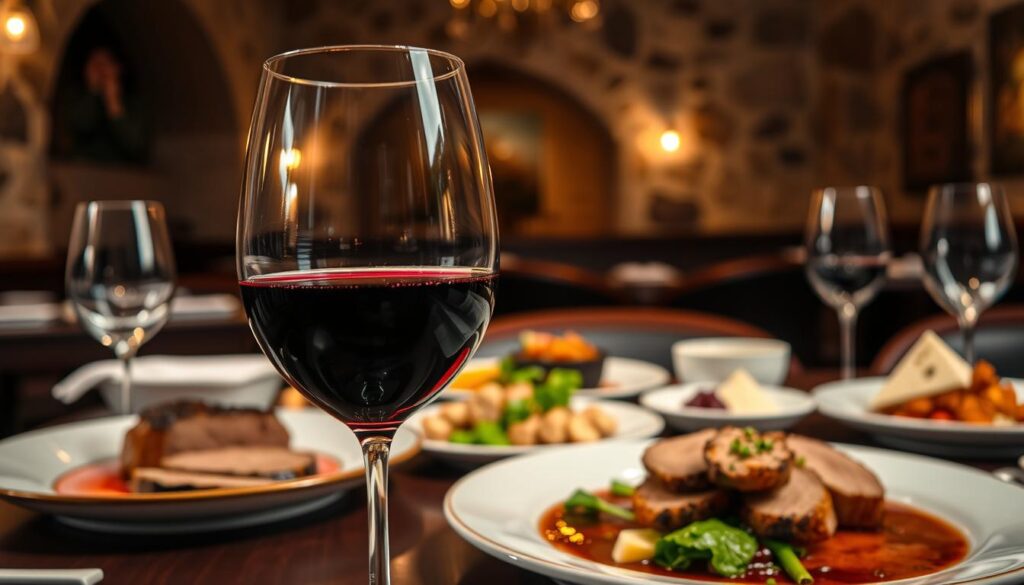
Exploring these regions can deepen your appreciation for French wine and its perfect matches with traditional dishes, making your cooking and dining experience even more delightful.
Must-Try French Appetizers
Embarking on a French culinary journey begins with delightful French appetizers that tantalize the taste buds. These must-try appetizers showcase the rich flavors and traditions of French cuisine, often served as the first course in gourmet dining. From classic French starters to modern takes, each option offers a unique taste experience that sets the stage for the main dishes to follow.
Start Your Meal with Delicious Options
Consider starting with the iconic Escargots or a warm bowl of French Onion Soup, both of which reflect the depth of flavor found in French culinary practices. Another popular choice is the Charcuterie board, featuring a selection of cured meats, cheeses, and garnishes that invite sharing and conversation. For those seeking something a bit different, Pissaladière, a Provençal pastry topped with caramelized onions, olives, and anchovies, offers a delectable taste of the South of France.
Classic Choices to Impress Your Guests
Prepare to impress your guests with classic French starters like Croque Monsieur, a delicious sandwich layered with ham, Gruyère cheese, and Mornay sauce. Another popular selection is Gougères, perfectly baked cheese puffs that pair excellently with a chilled glass of Champagne. Opting for Steak Tartare can also elevate the dining experience, as this dish showcases the freshest beef tenderloin often found in urban bistros. For a vegetarian option, consider the Socca, a chickpea pancake that aligns with the growing preference for lighter fare.

Indulging in these classic French appetizers not only enhances your meal but brings a touch of French elegance to your dining table. Each dish offers a glimpse into the culinary heritage of France, making them essential additions to your next dining experience.
Iconic French Main Courses
French main courses showcase the culinary artistry and diverse flavors found throughout the country. With both hearty and vegetarian options, these classic French dishes reflect regional traditions and seasonal ingredients. Two standout examples are Coq au Vin and Ratatouille, each offering a unique glimpse into France’s rich culinary heritage.
Coq au Vin: A Hearty Delight
Coq au Vin represents a celebrated classic among French main courses. This dish consists of chicken braised slowly in red wine, often accompanied by mushrooms and onions. The symphony of flavors results in a comforting and satisfying meal. Variations of this classic dish can highlight different regional wines, which add layers of taste and character.
Ratatouille: A Flavorful Vegetarian Option
Ratatouille is an essential part of French culinary identity, beautifully combining summer vegetables into a vibrant medley. This gourmet French meal often includes eggplant, zucchini, peppers, onions, and tomatoes, capturing the essence of fresh ingredients. Ideal for vegetarians and a wonderful side dish, Ratatouille exemplifies how simple components can create complex flavors in classic French dishes.
![]()
Decadent French Desserts You Can’t Resist
No meal is complete without a sweet treat, and French cuisine offers a spectacular array of options. When it comes to classic French sweets, Crème Brûlée and Tarte Tatin stand out as must-try desserts that showcase the artistry and flavor of French cooking.
The Allure of Crème Brûlée
Crème Brûlée boasts a rich, creamy texture that truly captivates the senses. Its allure lies not only in its flavor but also in the experience of cracking the caramelized sugar topping. A traditional recipe requires minimal ingredients: cream, sugar, eggs, and vanilla. For a delightful twist, consider adding rum or a hint of coffee to elevate the flavor profile. This dessert is perfect for special occasions, as it can be prepared ahead and served chilled, letting the vibrant taste shine.
Tarte Tatin: A Sweet Sensation
Tarte Tatin, an upside-down caramelized apple tart, embodies the spirit of French desserts by transforming simple ingredients into an elegant dish. The key to a successful Tarte Tatin lies in the caramel preparation, which requires a low and slow cooking method to achieve the perfect balance between sweetness and tartness. Serve this classic dessert warm, accompanied by a scoop of vanilla ice cream or a dollop of whipped cream, and relish the harmony of flavors.
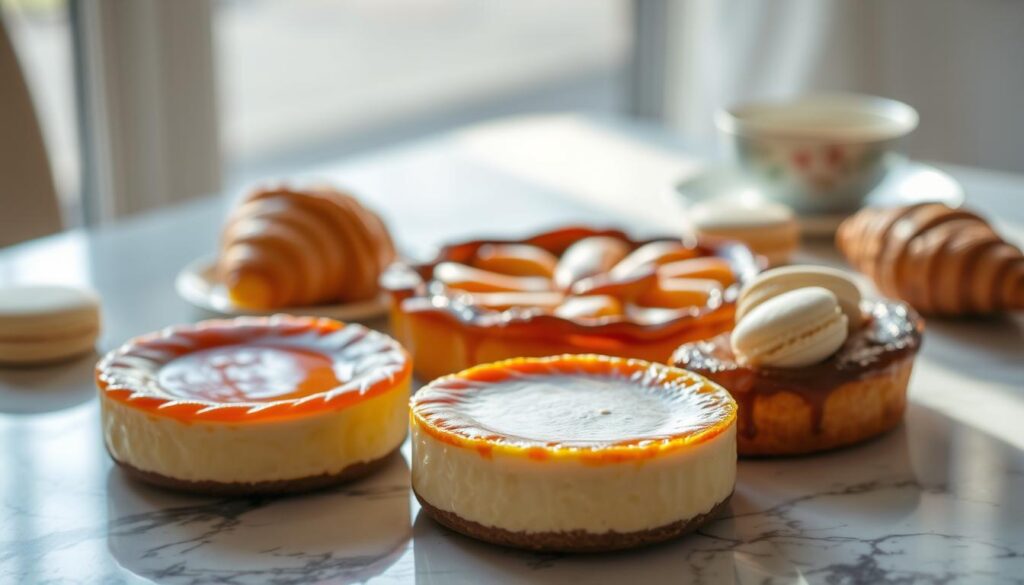
French Bread: The Foundation of Meals
In French cuisine, bread serves as an essential component that complements almost every meal. The rich history of French bread is interwoven with the country’s culinary tradition, making it an integral part of the dining experience. Understanding the different types of bread available can enhance your culinary journey, particularly as you explore the beloved baguette and its variations.
Types of French Bread You Should Know
French bread offers an array of delightful options that cater to various tastes. Here are some of the most renowned types of French bread:
- Baguette: The iconic baguette is celebrated for its crusty exterior and soft, airy interior. It is often used for gourmet sandwiches or simply paired with cheese.
- Pain de campagne: Known as country bread, it has a hearty flavor and is made from a mix of flours, commonly incorporating whole grains.
- Pain au levain: This sourdough variant is characterized by its bold taste, resulting from a natural fermentation process.
- Boule de Pain: A round loaf made from basic ingredients, ideal for a rustic touch at the dinner table.
- Pain au son: High in fiber, this bread contains a significant proportion of bran, making it a nutritious choice.
How to Enjoy Freshly Baked Baguettes
The experience of enjoying a freshly baked baguette is unparalleled. Consider these delightful ways to savor your baguette:
- Dipping it into flavorful soups enhances the overall taste experience.
- Pairing cheese with a warm baguette creates a classic combination that showcases the essence of French dining.
- Using it to make sandwiches varies the traditional offerings, allowing for creativity in meals.
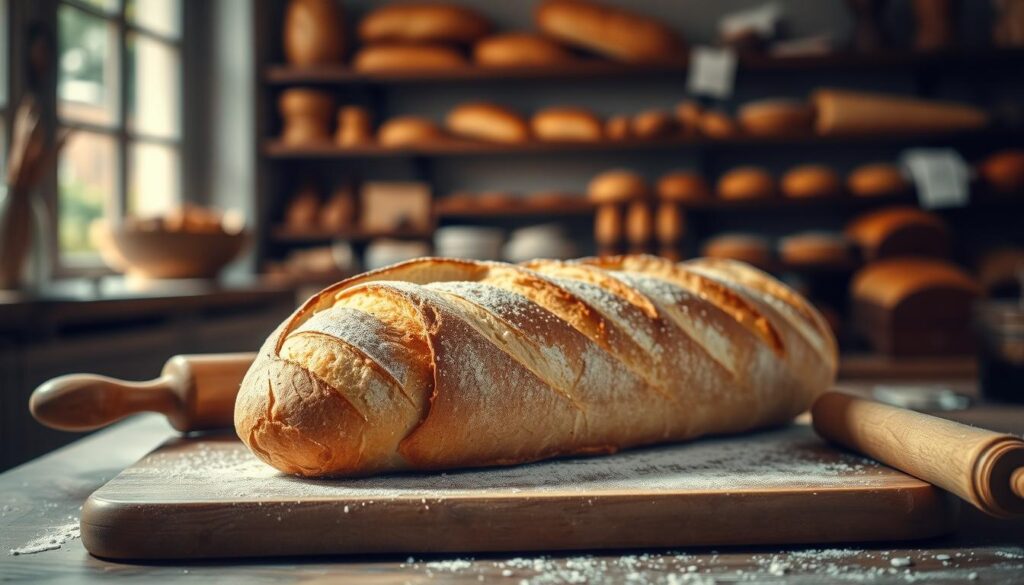
Embrace the art of artisan baking by trying to make your own baguette at home. This will deepen your appreciation for French bread and its role in meals, while connecting you to a tradition that’s centuries old. With the shift towards simpler and healthier options in modern cuisine, the rich flavors and textures of various types of French bread continue to thrive, making them a beloved staple across the globe.
Current Trends in French Cuisine
The culinary scene in France is vibrant and continuously adapting to global influences. Emphasizing both tradition and innovation, the current trends in French cuisine showcase how chefs are revitalizing classic recipes while experimenting with new flavor combinations. The integration of modern techniques and diverse cultural elements has led to a fascinating landscape of contemporary dining experiences.
Modern Twists on Classic Dishes
Today’s chefs are passionate about reinterpreting traditional French dishes with modern flair. Inspired by global culinary elements, these modern French dishes invite creativity without losing the essence of their origins. For example, adaptations of iconic recipes like coq au vin can incorporate less common ingredients, introducing an unexpected but delightful twist. This willingness to break away from convention reflects an age of culinary innovation where every meal becomes a canvas for artistic expression.
The Rise of Fusion French Cuisine
Fusion cuisine has gained notable traction, blending French cooking techniques with flavors and ingredients from around the world. This trend not only expands the palate but also showcases the richness of French culinary heritage. Plant-based claims, particularly in the dairy sector, have seen a significant increase, and seafood substitutes have emerged in response to health and environmental considerations. Consumers increasingly seek out flavors reminiscent of their restaurant experiences, further influencing the demand for innovative combinations in everyday meals.
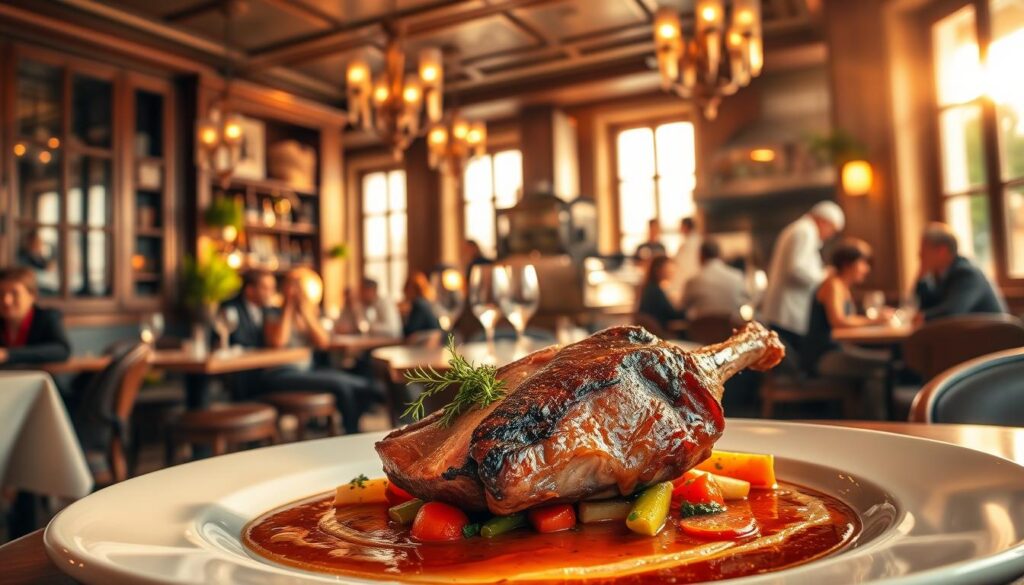
The Experience of Dining in a French Restaurant
Visiting a French restaurant offers more than a meal; it presents a chance to immerse yourself in a unique dining experience marked by tradition and finesse. The atmosphere of French dining enhances the enjoyment of meals, transforming each dish into a celebration. As you step into any French establishment, the inviting decor and attentive service create a cozy yet elegant environment that heightens your culinary adventure.
Tips for Enjoying Your Meal Fully
To make the most of your experience in French restaurants, consider these tips:
- Embrace the Apéritif: Start with an apéritif to set the tone for the evening. It allows you to relax and socialize before diving into your meal.
- Order Multiple Courses: Engage deeply with the menu by opting for at least two courses. This reflects the traditional dining culture and enhances your appreciation for the culinary intricacies.
- Savor Each Course: Take your time with every dish, allowing the flavors to unfold. Meals are meant to be enjoyed at a leisurely pace, often extending over two hours.
- Consider Prix Fixe Menus: These menus usually offer the freshest ingredients and are a wonderful way to explore popular local dishes.
The Atmosphere: More Than Just Food
The ambiance of a French restaurant significantly contributes to the overall dining experience. From the charming decor to the soft background music, every aspect has been crafted to encourage relaxation and enjoyment. Dining in France emphasizes a slower pace, encouraging you to take breaks between courses to enjoy conversation and companionship. The setting, combined with the rich traditions behind meal preparation, creates a memorable backdrop for enjoying meals. Even the way meals are served reflects a commitment to quality and respect for culinary artistry.

Ultimately, indulging in a French restaurant invites you to appreciate not just the food, but the entire experience of dining. This cherished tradition of enjoying meals draws upon a rich cultural heritage, making every visit an exploration of flavor and atmosphere that lingers long in the memory.
Hosting a French Dinner at Home
Hosting a French dinner at home transforms a regular evening into an elegant experience filled with rich flavors and delightful company. The key lies in thoughtful ambiance creation and meticulous meal planning. To set the scene, envision soft candlelight illuminating your table, accompanied by delicate floral arrangements that do not obstruct your guests’ views. A curated playlist featuring French music can also heighten the atmosphere, making your guests feel as though they are dining in a quaint bistro in Paris.
Creating the Perfect Ambiance
For successful ambiance creation, consider the following tips:
- Utilize cloth napkins instead of paper for a touch of elegance.
- Incorporate candles to enhance the warm and inviting feel of the space.
- Opt for low-profile floral arrangements to maintain open sightlines among guests.
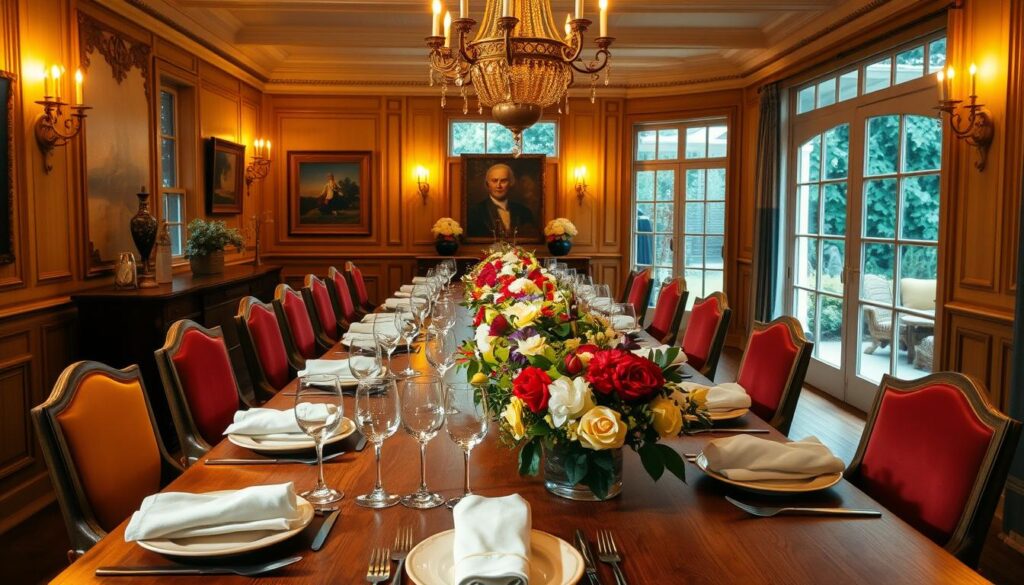
The ideal guest count for your French dinner party should be around 8 people or fewer, as this number allows for a more intimate dining experience. Traditionally, guests may arrive 10 to 15 minutes late, so it’s wise to prepare your home and meal to accommodate a leisurely start. Aim to commence the evening around 8 PM, aligning with French customs.
Meal Planning and Pairing Suggestions
Effective meal planning is crucial for a memorable French dinner at home. A classic French dinner typically consists of five courses: Apéro, Appetizer, Main Course, Cheese Course, and Dessert. Consider the following suggestions:
- Start with an Apéro featuring drinks paired with light bites, such as Le Chatelain Brie cheese and crispy baguette slices.
- For the appetizer, opt for Brioche toasts with pea and ricotta, which only take about 10 minutes to prepare.
- The main course can be a Rustic Ratatouille, which provides a flavorful vegetarian option and requires primarily hands-off preparation.
- Pair your meal with exceptional wines like TRIMBACH Pinot Gris Reserve 2013 or CHÂTEAU D’ESCLANS Whispering Angel Rosé 2016, both excellent choices to complement your courses.
- Finish the meal with delightful desserts such as the chocolate tart, prepared ahead of time for convenience.
Don’t forget to include a lovely selection of cheeses for your cheese course, featuring 2-3 varieties to impress your guests. Having both red and white wines available will accommodate every palate and enhance the overall dining experience. With thoughtful planning and a focus on ambiance, you will elevate your hosting dinners to a new level of sophistication.
The Cultural Significance of French Cuisine
Understanding the cultural significance of French cuisine reveals its deep connection to French identity. It serves as more than just a choice of food; it encapsulates a history rich in traditions and flavors. This culinary heritage is recognized globally, proudly acknowledged by UNESCO as an Intangible Cultural Heritage of Humanity. Within France, cuisine functions as a medium for community bonding and pride, allowing individuals to express their cultural identity through shared meals.
Food as an Expression of French Identity
Food represents a vital aspect of daily life in France. Approximately 70% of French citizens perceive their national cuisine as a key component of their cultural identity. Culinary practices reflect collective history and shared experiences, showcasing local ingredients and regional dishes. In this way, the diverse offerings, such as over 400 types of cheese, illustrate the rich tapestry of French gastronomy, which in turn fosters a sense of belonging and national pride.
Festivals Celebrating French Food
Food festivals across France play a significant role in preserving and promoting culinary traditions. Events like the Fête de la Gastronomie celebrate local gastronomy and the artistry of food preparation. These gatherings bring together communities, allowing them to explore their culinary heritage while highlighting the economic importance of the food and beverage market, valued at around €120 billion in 2022. Such festivals not only showcase the richness of regional dishes but also help in educating new generations about the cultural significance of French cuisine.

| Aspect | Detail |
|---|---|
| Recognition | UNESCO Intangible Cultural Heritage of Humanity |
| Cultural Identity | 70% of French citizens view cuisine as part of their identity |
| Market Value | Food and beverage market valued at €120 billion in 2022 |
| Culinary Employment | 1.5 million people employed in the restaurant and food service industry |
| Tourism Influence | 80% of tourists cite food as a primary reason for visiting France |
| Culinary Education | 25% increase in enrollment in French culinary schools in 2021 |
| Household Spending | Average annual spending of €3,500 on food |
Conclusion: Enjoy Your French Culinary Adventure
As we wrap up this exploration of French cuisine, it’s clear that embracing this culinary art form opens up a world rich in flavors, techniques, and traditions. The balance of simplicity and sophistication found in French cooking not only enhances your meals but also enriches your culinary experiences. Whether you find yourself dining in an authentic bistro in France or recreating classic recipes at home, each experience invites you to savor the beauty of French food culture.
Final Thoughts on Embracing French Cuisine
By indulging in French culinary adventure, you are not just enjoying exquisite dishes like ratatouille and crème brûlée, but also celebrating a tradition recognized as a UNESCO intangible cultural heritage since 2010. With every meal, you are participating in a legacy steeped in passion and skill, paving the way for experiencing new textures and tastes that remind you of the artistry involved in each dish.
Encouragement to Explore and Try New Dishes
Let the allure of exploring new dishes inspire you. Embrace the opportunity to experiment with French recipes in your kitchen by integrating local ingredients and classic techniques. Transform your dining routine into a delightful voyage of discovery as you incorporate the essence of French cuisine into your everyday meals. Remember, each new recipe you try is a step toward cultivating your own unique culinary experiences.
